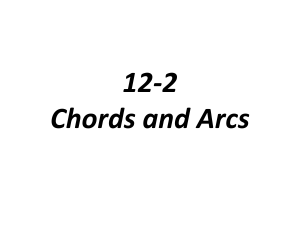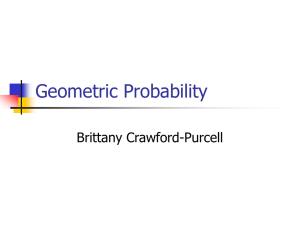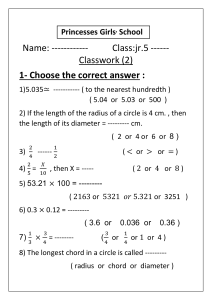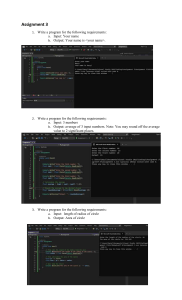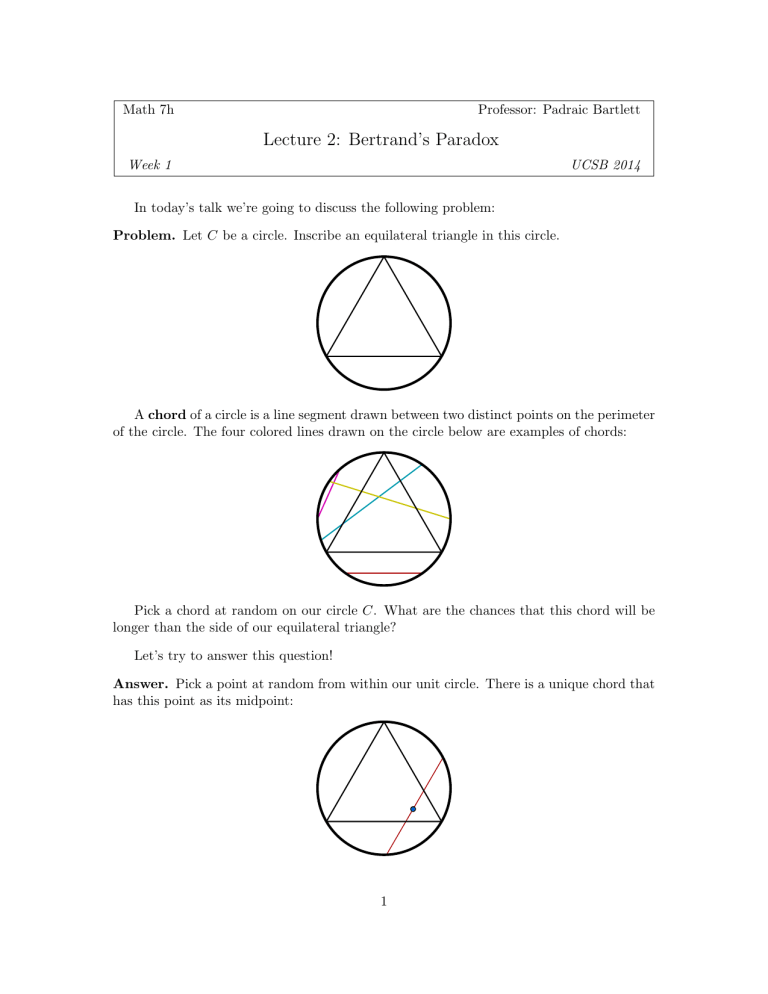
Math 7h Professor: Padraic Bartlett Lecture 2: Bertrand’s Paradox Week 1 UCSB 2014 In today’s talk we’re going to discuss the following problem: Problem. Let C be a circle. Inscribe an equilateral triangle in this circle. A chord of a circle is a line segment drawn between two distinct points on the perimeter of the circle. The four colored lines drawn on the circle below are examples of chords: Pick a chord at random on our circle C. What are the chances that this chord will be longer than the side of our equilateral triangle? Let’s try to answer this question! Answer. Pick a point at random from within our unit circle. There is a unique chord that has this point as its midpoint: 1 This gives us a way to randomly pick out a random chord! Draw a circle inscribed inside of this triangle. This chord is longer than a side of our equilateral triangle if and only if it is contained within this circle: to see why, look at the picture below! So: how big is this smaller circle? Well, if we look at the picture below, we can see that it has radius r/2: r r/2 Therefore, it has area 1/4 of the original circle! So our chances of picking a point in this circle is just 1/4: i.e. a quarter of the time, this method of picking a random chord will give us a chord longer than a side of our equilateral triangle. Ok, so 1/4 is the answer. To double-check our calculations, let’s try a different method: Answer. Consider the following second method for picking a random chord. First, pick a random point on the perimeter of our circle. By rotating our circle, we can ask that this point was without loss of generality the exact topmost point in the picture below: Pick another point on the perimeter. What are the chances that the chord formed by these two points is longer than a side of the equilateral triangle? 2 Well: 1/3 of the time, we will pick a point from the green region in the circle drawn above: in that situation, we will have a chord longer than a side of our equilateral triangle. The other 2/3rds of the time, we will pick a point from the red region, which will result in a chord shorter than a side of our equilateral triangle. So a third of the time, we will pick a point that is longer than a side of our equilateral triangle! Um. This didn’t agree with our first answer. Maybe trying a third method will clear things up: Answer. Consider the following third method for picking a random chord. First, pick a random radius, i.e. a random line from the center of our circle to the origin. Now, pick a random point on that radius, and draw the chord formed by taking a line perpendicular to on the perimeter of our circle. From our image, it is clear that this chord will be longer than a side of our equilateral triangle if and only if the point chosen is contained within our equilateral triangle (i.e. in the green region drawn.) In our first method, we showed that this green segment has length r/2. Therefore, the length of the red segment is just r − r/2 = r/2, and the probability that we choose a chord longer than a side of our equilateral triangle is just 1/2. Oh dear. Maybe if we try a fourth method? Answer. Consider the following fourth method for creating a chord: pick two random points in our circle, and draw a chord between them. 3 How long is this chord expected to be? Well: let’s think about picking our points one at a time. By rotating, we can assume that the first point we pick is on the radial line connecting our circle’s center with its bottom-most point. To simplify, let’s assume that our circle √ has radius 1. Then we are asking whether our chord has length greater or smaller than 3, which is the side length of our inscribed equilateral triangle (as illustrated below.) 1 1/2 √3/4 There are two cases from here: either our chosen point has distance ≤ 1/2 from the origin, or distance longer than 1/2 from the origin. Suppose that our point is distance h ≤ 1/2 from the origin: i.e. on the green dashed line. Then any chord through this point will have length longer than the base of our equilateral triangle, for similar reasons to the ones we used when discussing our first method. 4 In the other case, our point is distance h > 1/2 from the origin. In this case, there are possible chords of length shorter than the base of our equilateral triangle! Consider the following figure: In this image, there are chords through our point that are shorter than the base of our equilateral triangle (the red chord,) and other chords that are longer than the base of our equilateral triangle (the green chord!) So: how can we tell these apart? First, notice that the shortest chord through our chosen point is the one parallel to horizontal, while the longest chord is the chord that is parallel to vertical. Furthermore, note that if we identify chords through our chosen point with the angle they make, the length of chords increases as we “sweep” from horizontal to vertical. In particular, consider the following operation: take two copies of our equilateral triangle. For each equilaterial triangle, rotate it around the center of our circle until it intersects our chosen point, as illustrated below. Doing this, as √ illustrated before, tells √ us the “cutoff” points at which chords transition from shorter than 3 to longer than 3: 5 Our question is now the following: given a point with distance > 1/2 from the origin, what is the likelihood of picking a point in the “red” region as illustrated above to construct our chord with? Given that we are picking the second point at random through our entire circle, this is just asking us for the ratio of the area of the red part to the area of the entire circle (i.e. our odds of picking a red point out of all of the points in our circle.) This is not impossible to calculate. To start, draw the following figure: A α 1 B β γ h √3 θ π-θ D 1 δ C √ In this figure, ∆ABC is a triangle with two sides of length 1 and one side of length 3. Some basic trigonometry (pick your own favorite way to show this) tells us that the angles α, δ are both equal to π/6, while the sum β + γ is π/3. If we rewrite things in terms of θ, we get β = 5π/6 − θ and γ = θ − π/6. Now, if we apply the law of sines to the triangle ∆ABD, we get h 1 = , sin(π/6) sin(θ) 6 which if we solve for θ in terms of h, gives us θ = sin−1 (1/2h). With this trig done: notice that we can write the red-shaded area from before as the following sum. =2· -4· We can find these areas! Specifically, notice that the first area is simply 1/3 the total √ area of our circle, minus the area of the triangle with side lengths 1, 1, 3: 1 2π/3 √3 1 This is just √ 2π/3 1 π 3 − 1 · 1 · sin(2π/3) = − , 2 2 3 4 if we use the formula that tells us that the area of a triangle with side-angle-side given by a, φ, b is 12 ab sin(φ). Calculating the area of the other piece is not much harder. θ-π/6 1 h π-θ π/6 The area of the shaded region above is just the area of the wedge of our circle given by the angle θ − π/6, minus the area of the triangle with sides 1, h and angle θ − π/6: in other words, it’s θ − π/6 1 − · 1 · h · sin(θ − π/6). 2 2 7 Therefore, given any point at distance h > 1/2 from the origin, the total area shaded in red is √ ! −1 π 3 sin (1/2h) − π/6 h A(h) = 2 − − − sin(sin−1 (1/2h) − π/6) . 3 4 2 2 Therefore, the odds of picking a point in this area out of our entire circle is just the above quantity divided by π, and the odds of not picking such a point is just 1 − A(h)/π. So: this tells us our odds of picking a second point that gives us a chord of length shorter than one side of our equilateral triangle, given a first point at distance h. How do we determine our total odds of picking two points that give us a chord of side length shorter √ than 3? As noted √ before, points of distance h with h ≤ 1/2 always give us chords of length greater than 3; given that the area of the circle of radius 1/2 is π/4, this means that we 1 have a π/4 π = 4 chance of picking such a point for our first point. If this first point is distance h > 1/2 from the origin, we know that the area of the red region corresponding to “short” chords is just A(h). The average value of A(h) over all such points, therefore, is just the average value of A(h) over the set of all points with distance between 1/2 and 1 from the origin. In other words, it’s the integral of A(h), thought of as a polar function that only cares about the radius h, over the set of all points with h ∈ [1/2, 1], α ∈ [0, 2π], divided by the area of that set of points! In other words, this is just Z 1 Z 2π Z 1 8 1 A(h)h dhdα = h · A(h) dh. 3π/4 1/2 0 3 1/2 Plug this into your favorite integration software, because it’s pretty rough, and you’ll get Z 8 1 h · A(h) dh ≈ .5823. 3 1/2 . Therefore, the odds of not picking a point in this red region is just 1 − √ So, in total, our odds of picking a chord with length greater than 3 is (1/4) · 1 + (3/4) · .8146 ≈ .861. . . . which is not equal to our first, second, or third answers. . . 8 .5823 π = .8146.

